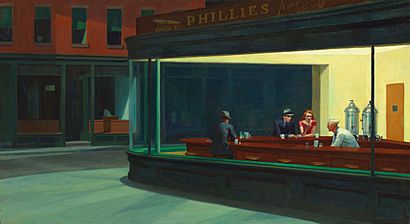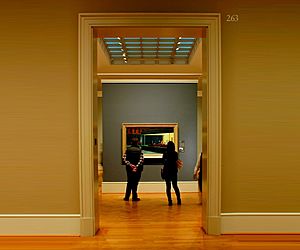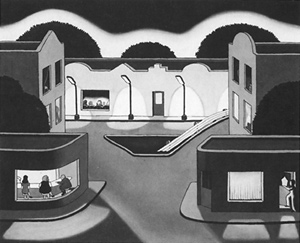Nighthawks (Hopper) facts for kids
Quick facts for kids Nighthawks |
|
|---|---|
 |
|
| Artist | Edward Hopper |
| Year | 1942 |
| Medium | oil paint, canvas |
| Movement | American realism |
| Dimensions | 84.1 cm (33.1 in) × 152.4 cm (60.0 in) |
| Location | Art Institute of Chicago |
| Accession No. | 1942.51 |
Nighthawks is a famous painting from 1942 by Edward Hopper. It shows four people inside a downtown diner late at night. You see them through the diner's big glass window. The bright light from the diner shines onto a dark, empty city street.
This painting is one of Hopper's most well-known works. It is also one of the most famous paintings in American art. Soon after it was finished, the painting was sold to the Art Institute of Chicago in May 1942.
Contents
About the Painting's Meaning

Some people think Hopper was inspired by short stories by Ernest Hemingway. These stories often showed lonely characters.
When asked if the painting was about loneliness, Hopper said he didn't see it that way. But he also said he was probably painting "the loneliness of a large city" without even realizing it.
Where the Diner Might Be
The scene in Nighthawks was likely inspired by a real diner. This diner was in Greenwich Village, a neighborhood in New York City where Hopper lived. Hopper himself said the painting was "suggested by a restaurant on Greenwich Avenue where two streets meet." He also mentioned that he "simplified the scene a great deal and made the restaurant bigger."
Many fans have tried to find the exact spot of the diner. One popular idea was a vacant lot called Mulry Square. However, a gas station was on that lot from the 1930s to the 1970s. This means it couldn't have been the diner's location.
It seems Hopper took ideas from different places to create the diner. So, there probably wasn't one exact real-life place that looked exactly like the painting. Hopper used his imagination to make the scene.
Nighthawks in Pop Culture
Because Nighthawks is so famous, many artists and creators have used it as inspiration. They make their own versions or parodies of the diner scene.
Art and Sculpture Inspired by Nighthawks
Many artists have created works that refer to Nighthawks.
- Artists like Ralph Goings and Richard Estes were influenced by Hopper. They painted diners and city scenes with large windows.
- Gottfried Helnwein's painting Boulevard of Broken Dreams (1984) shows famous American stars like Humphrey Bogart and Marilyn Monroe in the diner.
- A 2005 Banksy artwork shows a soccer fan outside the diner, having just broken the window.
- A large mural of Nighthawks was painted on an old Chinese restaurant in Santa Rosa, California.
Books and Stories
Writers have also imagined stories about the people in the diner.
- Joyce Carol Oates wrote a poem called "Edward Hopper's Nighthawks, 1942."
- Other writers like Wolf Wondratschek and Erik Jendresen have also written poems or short stories inspired by the painting.
Movies and Films
Hopper loved movies, and his paintings often look like movie scenes. Nighthawks has influenced the look of many films.
- The movie Pennies from Heaven (1981) recreated the Nighthawks diner as a set.
- Director Ridley Scott used Nighthawks as inspiration for the look of the movie Blade Runner. He wanted the film to have a similar mood.
- The painting appears briefly in the animated film Heavy Traffic (1973).
- In the movie Night at the Museum: Battle of the Smithsonian (2009), the painting comes to life with the characters moving.
Music and Songs
- Tom Waits's album Nighthawks at the Diner (1975) was named after the painting. Its cover and songs were also inspired by it.
- The band Orchestral Manoeuvres in the Dark mentions Hopper and Nighthawks in their song "Night Café."
TV Shows
- The TV show CSI: Crime Scene Investigation once placed its characters in a version of the painting.
- The poster for Fresh Off the Boat Season 2 shows the family in the Nighthawks diner.
- An episode of That '70s Show ends with the characters in a diner that turns into the Nighthawks painting.
Other Interesting Facts
- Some model train builders have recreated the Nighthawks scene for their layouts.
- A company called Electronic Theatre Controls has a life-sized model of the diner in their office lobby.
Fun Parodies
Nighthawks has been copied and made fun of in many ways. You can find versions on posters, T-shirts, and even in comic books. These parodies often keep the diner and its unique angle but change the people inside. For example, they might show animals, Santa Claus, or cartoon characters.
One famous parody is Michael Bedard's Window Shopping (1989), which shows ducks in the diner. This parody then inspired another parody called Boulevard of Broken Ducks (1993)!
Images for kids
See also
 In Spanish: Nighthawks para niños
In Spanish: Nighthawks para niños




